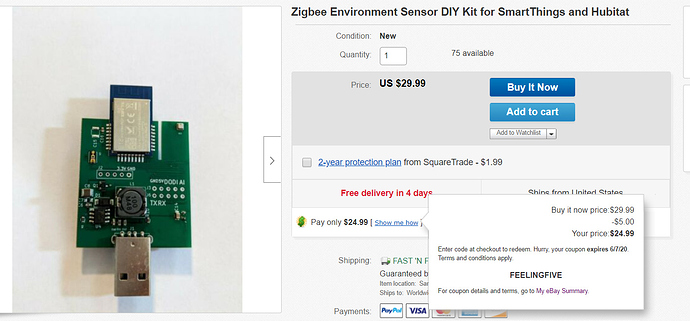We do have temperature for the formula to work. We need to get the altitude. Our hub has location (latitude and longitude). But the altitude can be different depend on how high the sensor is placed in the house. It is a not big deal since some of my sensor can differ about 0.1 kPA between second and first floor in my house.
Are you saying we can ignore the small height differences when you have multi level home? If someone live in high rise apartment, the pressure will be different between first floor vs 24th floor for example.
Do you know how to calculate the altitude where the sensor is placed? I am open to get this to work with a reasonable way to get altitude.
I have been playing around with GPS module. There is an altitude data. But, GPS is not good in door. I am not sure that it can get a lock just to get the altitude.
Thanks
Iman
Yeah, I know that google has roughly the same API. It is just does not have final altitude where the sensor is placed. This is an issue if you live in a high rise building.
Thanks
Iman
The troposphere is the lowest layer of Earth's atmosphere thats where 99% of gases are. It extends from Earth's surface to an average height of about 12 kilometers.
In reality, 10 meters is almost no difference.
most sensors are under 10m.
High risers usually have their own air-conditioning system with pressure independent on outside conditions, windows can't be open. Unless you put it on the roof it can't be used anyway.
Hi Everyone,
I created a listing for my sensor on Ebay. For those who are interested on getting one and find Ebay is more convenient, Here is the link. These are the sensor that is manufactured per as I mentioned a few post back.
Shipping is free to any US address. I used to use paypal for shipping. It seems Ebay may have better shipping rate for international destination as well. I am using USPS for carrier. Please help me check the status of the USPS delivery condition to the country that you will be shipping the sensor here.
For those who has eligible Ebay account, you may get $5 off. This is not my promotion. I do not have any control who got it.
Thanks
Iman
Going to try one out. I will probably print a case for it though.
If you can print cases, I'd be interested in purchasing 4. Thanks!
Thank you. For the enclosure, look at @brianspranger stuff at thingverse.
I play around with 3D printer and try to make a case of it. There may be some adjustment that you need to make.
Thanks
Iman
link to the case
@iharyadi just curious if the new board illuminance sensor is affected by IR light? I noticed tonight that your original ESEx board is affected which was throwing off my illuminance readings.
I am using TEMT6000 sensor for light. According to the datasheet, there is ir sensitivity that the sensor is impacted. It should not be much.
I am not able to attach the Datasheet. I will as I got access to my pc.
Just FYI, the sensitivity on ir spectrum is really low.
The impact was high and even though the real lux was 0 with the IR it was registering over 2000 at 100 feet.
Here is a vendor in amazon describe the sensor. It is much better than what I can interpret from the datasheet.
The maximum sensitivity TEMT6000 sensor for 570nm, having a 60 wide angle of half sensitivity.
While this device is very sensitive to ambient light, but which inhibit infrared (IR) spectrum, which can provide similar "to the human eye," the visible spectrum greater responsiveness.
TEMT6000 is designed to be close to human sensitivity including small ir sensitivity.
If your application required zero sensitivity, the only way I can think of is to place a filter in front of it.
Ok.. I'll look around for a filter I can put in front of it.
FYI,
That red area show that there is still some sensitivity.
I am curious and interested that about the need of have filtered IR? It is important for me to learn how people use the sensors.
Thanks
Iman
I use mine on the porch for turning the outdoor lights on/off and setting the outdoor ceiling fan speeds. On my porch I have CCTV 2 cameras and they throw off IR and it distorts the lux reading.
That is strange that the sensor report 20000. I never seen anything like this. Do you happen use illumination adjustment on the preference? If you enable this setting, the value is not in lux.
I personally never seen 20000 lux reported from my sensor.
It was 2000 sorry extra 0 got in it
Actually, I never seen value close to 2000 either. I think in your case, the setting for illumination adjustment is enabled? I had request that if this setting is enabled, the illumination is not converted back to lux.
In Zigbee, the illumination is reported as follow.
A value of 2000 (assume that this is the MeasuredValue.
2000 = 10000 log10(IL)-1
1999/10000 = log10(iL)
Solving for iL, the lux value is ~1.5. The value of 1.5lux is not a pitch dark. It is also not even typical 60 watt bulb light.
Thanks
Iman





